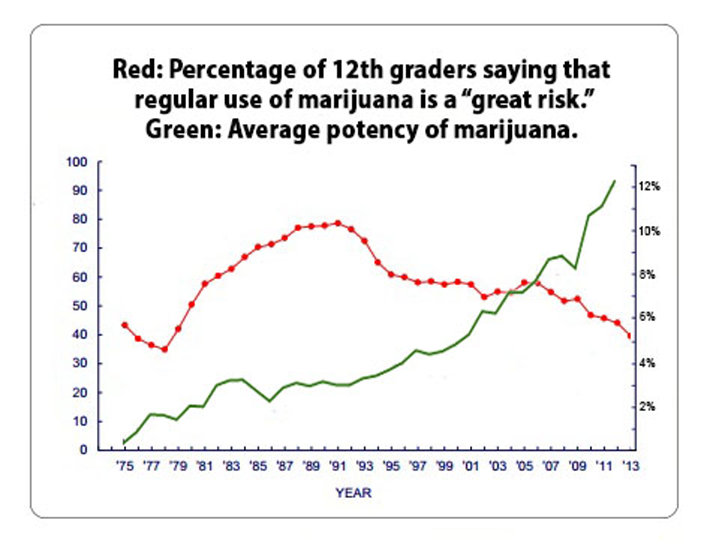Marijuana Potency Soars While Youth’s Perception of Harm Drops

This chart compares two statistics: How many twelfth grade students feel that the regular use of marijuana is a “great risk,” and the average potency of marijuana seized by law enforcement and sent for testing. You’ll notice that in 1991, the perception of risk by our high school seniors began to drop. In other words, fewer 17- or 18-year-olds felt that regular use of marijuana was dangerous. It’s declined almost every year since. Now, fewer than 40% of these students see a threat in regular marijuana use.
The green line represents the results of marijuana potency tests performed by the University of Mississippi Potency Monitoring Project. In 1975, the average potency was .48%—in other words, less than one percent of the mass of the samples tested consisted of the intoxicating drug tetrahydrocannabinol (THC).
This potency rose in fits and starts until the late 1990s when it really began to climb. It’s interesting to note that the first legalization of the medical use of marijuana was in 1996 in California.
As of 2012, the average potency of seized samples was 12.3%. Of course, some samples tested much higher than this. If you purchase marijuana from a medical supplier, some of them claim potencies in the high 20s. The highest sample tested by the Mississippi project was more than 37% THC.
These high potencies are offset by lower-potency marijuana coming across the border from Mexico. The bad news is that the Mexican marijuana producers are now increasing the potency of their products so they can compete with the higher potency strains grown in the US and Canada. So the increasing potency of Mexican pot is now bringing that average up.
There has not yet been a scientific study of the matter, but it would be a logical conclusion that higher potency marijuana would be more addictive. Already, one in six teens who start smoking marijuana will become addicted to it, according to the National Institute on Drug Abuse.
There’s no sign that either one of these graphs is going to level out any time soon. Therefore, we can expect that in a few years’ time, even more teens will feel that smoking pot is a harmless activity and that the potency of pot will be higher than today’s drug. This could be a recipe for disaster, with more young people becoming addicted, injured or otherwise harmed by their use of pot. The only responsible answer is to prevent the abuse of this drug, especially by our youth.
Sources:
- http://www.politifact.com/rhode-island/statements/2014/mar/30/heidi-heilman/marijuana-legalization-opponent-heidi-heilman-says/
- http://www.monitoringthefuture.org//pubs/monographs/mtf-vol1_2013.pdf
- http://www.borderlandbeat.com/2010/12/mexico-marijuana-growers-learn-new.html
- http://www.drugabuse.gov/sites/default/files/teens_brochure_2013.pdf


 ®
®